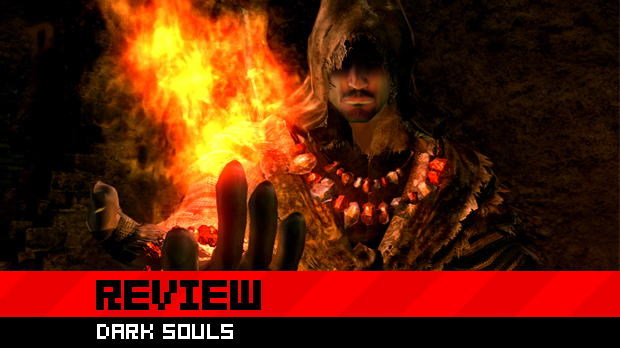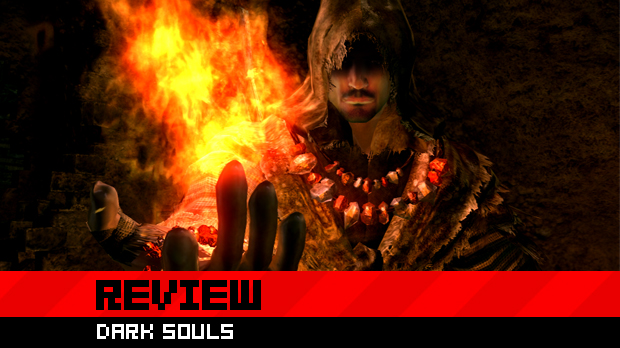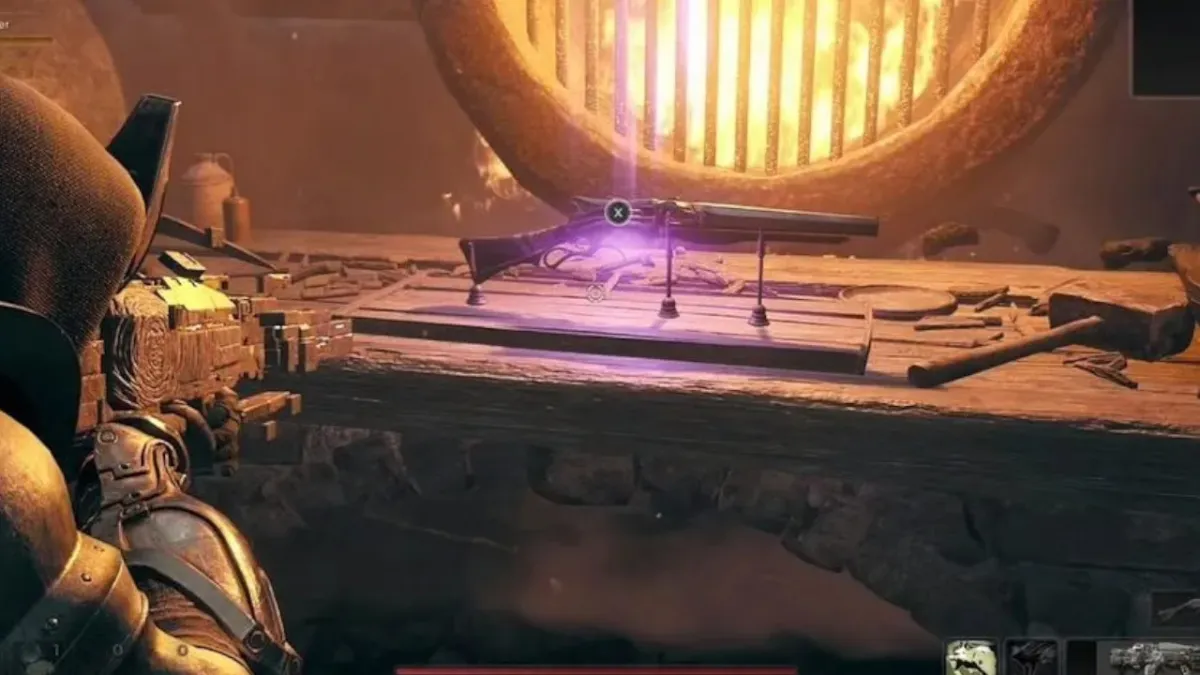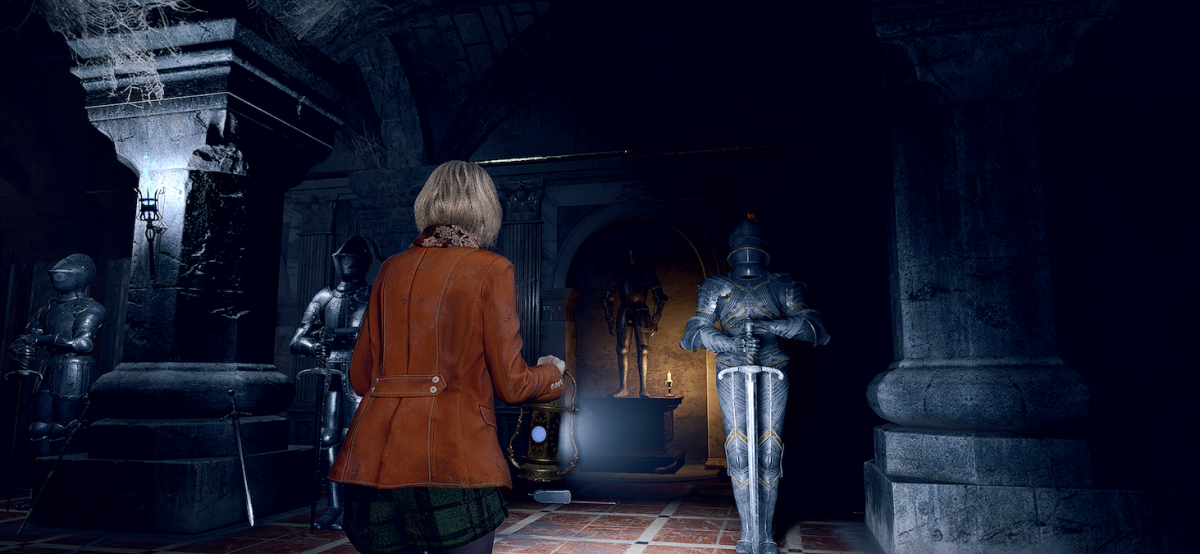First, allow me to begin with a caveat; I have not completed Dark Souls. I have invested over 90 hours of play into the game, exploring the vast majority of its world and facing off against (if not defeating) many of the boss enemies. I am confident that I am capable of rendering a fair verdict based upon the knowledge I have. If you are not, I respect that and ask that you please enjoy one of the many fine reviews available from players more capable of completing this quest than I have been.
You are undead, one of the chosen few tasked with saving a world which has very nearly seen its demise. The primeval, life-giving power of fire which holds back the darkness threatening to once again consume all existence, has almost flickered out and you are the prophesied last hope, sojourning to the legendary land of Lordran to reignite the flame. Between you and the fate of the world lies hundreds of mindless beasts intent on killing you, which they will succeed in time and again.

Dark Souls (PlayStation 3 [reviewed], Xbox 360)
Developer: From Software
Publisher: Namco Bandai
Released: October 4, 2011
MSRP: $59.99
Dark Souls is vicious and unforgiving in the challenge it presents. At the beginning, you are weak and anything is capable of bringing a swift end. When you have developed your abilities and mastery of the controls, you will be able to swiftly cut down most common enemies, making the greater threat your own carelessness and over-confidence. And no matter how big or bad you think you are, there’s always something (or someone) bigger and badder.
The complexity of the mechanics at play is vast. Behind everything are souls, the currency of Lordran. Souls are accumulated from fallen enemies or by using consumable items found in the world and are spent on everything. Improving your character’s eight basic stats, upgrading and repairing equipment, purchasing items and information from NPC characters; all of these things require the expenditure of souls. In the case of leveling up stats, the expense of doing so rapidly rises with each level, starting at a few hundred and in excess of ten thousand by your fiftieth point. Weapons upgrade with the cost of souls and components and require finding an NPC blacksmith for every five levels you improve them. And then you have to be able to carry all the crap you’re wearing and still walk. There is a lot of growing you’ll do and you’ll need souls for all of it.
So, souls are valuable and the reason why Dark Souls is such an intense challenge that always pushes you to improve your performance. When you inevitably die, any souls you were carrying are left a few steps back from where you met your end. They can be recollected, provided you return to this point and grab them before you are killed again, the bloodstain only appearing at the point of your most recent death.

Success in Dark Souls means always moving forward. It means always learning from every experience that you have and applying that learned knowledge towards, at a minimum, achieving as much success as you have in previous efforts if not more. It makes your achievements deeply satisfying when you earn them and your failures all the more personal as they represent a very real loss of time and energy.
Lordran is an amazing world, a dark honeycomb of twisting paths and chambers. Right from your arrival (following a brief tutorial stage), you are free to begin exploring with three clearly available paths and it only continues to branch out from there. There’s a fantastic breadth of variety in the regions, though all evoke a sense of isolation and fear in their atmosphere. All of this world is broken and ruined.
Environment design and enemy placement are by far the most impressive aspects of Dark Souls. Every corner has a new surprise, a new opportunity to meet an untimely end from an ambushing enemy or trap. It’s consistently challenging and even nerve-wracking to push into unknown territory and the game has no compunctions about bringing a swift end the moment you let your guard down. On the rare occasion that you can outwit the design and anticipate its next move, elation follows.
Thankfully, Dark Souls does a very good job of never making you traverse too much of an area on one go. Bonfires littered around the world act as checkpoints, providing a safe haven to spend souls on increasing attributes and (once necessary items are acquired) improving equipment, as well as acting as a revival point to return to when killed. These bonfires, combined with frequent opportunities to open shortcuts ensure that you’re never too far away from making progress.

Which is a good thing, because you’re going to have a hard enough time getting to the bosses, let alone getting back to them to fight a second or tenth time. Boss encounters usually end swiftly the first time, often only educating you in terms of how much time you have to dodge and in what direction it would be best to go immediately upon entering the room when you return. After that first failure, subsequent efforts will allow you to find environmental features to aid you in defense and combat opportunities while seeing the full range of attacks.
Sometimes, the environment in a boss fight is really valuable. There are some very easy ways to eliminate certain bosses by getting a high vantage point and leaping on to them, but I found that most battles tended to come down to getting off to the side of an enemy, right next to them, and hacking away until they move. There are probably more elegant means of dispatching some that I never found, but most of the bosses are basically on your ass from the minute you step in the door and close range as quickly as possible whenever you can create some distance, which seemed to limit the potential of some approaches.
Secrets are tucked away in great quantity throughout Lordran and the soft glow of an item in a seemingly inaccessible area is a tantalizing lure for the explorer. At times, however, the direction you’re expected to take to reach a new location can be rather tough to spot. A fair bit of my play session was lost to wandering, pushing at edges and boundaries to find the door to a new area, having seemingly exhausted all my options only to discover an overlooked path some hours later when a message left by another player showed the way.
This desire to make you discover how stuff works permeates the entire experience. Players exchange all sorts of information about impending threats, hidden treasures and the locations of valuable NPCs by leaving notes for other people to find. These glowing bits of text litter the world. Some warnings are helpful while other people use the system to grief anonymously but the value of it is undeniable.
From Software is deliberately vague. The included six-page manual covers only the barest essentials, while in-game help clarifies how many of the character statistics affect one another. That’s about all the help you’re going to get directly from within the game, as the player is meant to discover much of how the things work on their own. The best it has to offer beyond that are the often cryptic rantings of the degenerating populace of non-player characters around the world. It’s up to the players to learn and share knowledge of the game and its mechanics, which means this game is going to have some very long legs as all its secrets are uncovered.
Let’s take the game’s most significant mechanic and valuable attribute, Humanity, as an example. Players in Dark Souls exist in two states, “Human” and “Hollow,” with the latter being attained in death and reversed by sacrificing Humanity at bonfires. While alive, you are both more powerful and more at risk, as you open yourself up those from worlds beyond your own. Humanity can be earned slowly by defeating regular enemies, acquired through use of a consumable item or by invading the worlds of others and stealing it from them. And, like souls, humanity you carry is left where you die and must be collected again or lost forever.

In a hollow state, you can only participate in online play when a living player calls for you, with the use of a summoning mark you leave in the world. Only when human can you take direct action to participate in multiplayer, either invading the worlds of others as a phantom to steal their humanity or by calling phantoms to assist you in defeating the area boss. But, just as you can force yourself into someone else’s world while alive, they can do the same to you and you’ll be under the constant risk that an obscenely powerful player might find their way into your game and bring an untimely end to your progress. [A clarification: Dark Souls is balanced in its PVP system to match players based on their statistics; “powerful,” a poor choice of words, should in fact be taken to mean “skilled.” – Ed]
That’s only the surface-level, direct function of Humanity. There’s another, more subtle layer at work. It is also treated as an attribute of sorts, providing bonuses to a range of your other statistics. The full breadth of its effects are a secret closely held to the chest of From Software, but it has a very clear (and noted) effect on your item discovery rate. Having humanity on-hand provides a huge advantage in discovering items (just one point will give a 20% bonus, with smaller bonuses for additional points), crucial in the latter portions of the game as less common components become required to upgrade weapons to their absolute potential.
This sense of vague mystery about the nature of some mechanics can go a bit too far at times, however. Players who wish to attempt to focus on Pyromancy, perhaps the most versatile of the game’s three magical disciplines, will likely struggle for some time wondering what it’s good for and how to improve one’s ability. I traversed what I estimate to be twenty to thirty percent of the game before meeting an NPC who could teach new Pyromancy spells and increase the effectiveness of those I had.
What really hurts the experience of Dark Souls is a number of technical faults and limitations. Some of these problems are of the sort where to point them out risks a derisive response in regards to the skill of the person saying them. That’s the kind of reputation Demon’s Souls had and it will persist amongst a certain class of entitled, skilled gamers for this game. I include them in this list because I am convinced that they are real and, in most cases, were witnessed by more than just myself.

While Dark Souls looks damn good, it struggles to maintain its framerate whenever the action gets thick. Nearly every boss encounter I had suffered from dropped frames as the game strained to keep up with all the effects and animations. More often than not, it heightens the drama with fairly limited impact on the battle, but it’s terrifying nonetheless to see the game drag when you have next to no health and are hammering on the button to heal.
Collision detection seems generally good but sometimes doesn’t feel right. On many occasions, I have seen the blade of my weapon pass through the head of an enemy following an attack when they should be most vulnerable, only to whiff (the white, winged beasts of Anor Londo provide a key example). Clipping can be a problem. Enemies will sometimes become stuck in walls, attacks that should be incapable of penetrating will still deal damage (easily exploited by the player). Sometimes enemies running into a wall will eventually clip through it, out of the level geometry and to their deaths.
Inconsistencies are present regarding the penetration of terrain, also. Using a ranged weapon to fire through a gap in a wall or fence might work perfectly well in one place, while another spot five feet away with nearly identical design allows no trespass. Occasionally, you’ll give the command for your character to attack or use an item and he’ll stand there and do nothing for a bit before he decides to execute for no discernible reason. Enemy lock-on, essential for blocking attacks, often has difficulty switching between targets and can play hell on the camera in some circumstances
The most egregious of all faults lies in the enemy AI. Nearly all creatures in Dark Souls are hyper-aggressive and many of them to a fault. Some will completely ignore a gap between you and them, running off a cliff. Creatures with wings who demonstrate flight will try to land where there is no solid surface fall to their deaths because they can’t actually fly with any sense of freedom. Enemies will chase you doggedly, but only up to a defined point, whereupon they’ll turn back and allow you to exploit their instinctive need to return.
This is a particularly significant failure when it comes to the player’s use of ranged weapons, as enemies can be easily lured and defeated one at a time, while his buddies sit and wait for their turn to notice you ten feet away. Worse still, attacking enemies from positions outside of their perceptive range generally provokes no response whatsoever. The patient player can usually fire less than two hundred arrows (at a cost of three souls each) from a distance and be guaranteed a challenge-free kill of the biggest beasts roaming Lordran, undermining the entire design of the game.
That said, if you’re shooting hundreds of cheap arrows into an enemy from a distance to kill it because it’s just going to take it, you know as a player that you’re taking advantage of the game. So it becomes a question as to whether the ability for the player to circumvent the programming limitations of the game to create an unintended advantage constitutes a failure on the part of the designers to account for it or a failure on the part of the player who is “cheating” to achieve success.
That’s a philosophical question which is probably too weighty for this review. Suffice to say that the issue exists in Dark Souls when it need not have.

The other thing to keep in mind when addressing these faults is that, while they are many, I have spent 90 hours playing the game. These are developed over a long timeline and, at the end of the day, will affect the experience in different quantity for everyone. Occasionally annoying, often exploitable, the bugs are there but none of them are game-breaking.
When they occasionally result in your untimely demise, they can be very frustrating. More often than not, something else probably would have killed you shortly anyway. The player who exploits the weak AI will help themselves a bit in pushing through the game, but won’t do them a bit of good in preparing to deal with online incursions in the late game as they scramble to improve weapons and learn how not to be a lazy player.
It’s easy to make justifications for a game effectively designed around the idea of making the player’s life Hell when it succeeds. Dark Souls does so where it needs to in order to appeal to an audience hungry for a follow up to Demon’s Souls. It’s engrossing, challenging and inspiring in its world but also a sticky mess of unexplained elements and niggling problems.
It’s still a good game, one that improves upon its impressive predecessor in many ways and fails to improve in some important ones. It calls for me to return, to finish what I have started. And I will, because it deserves to be played and demands to be conquered.





